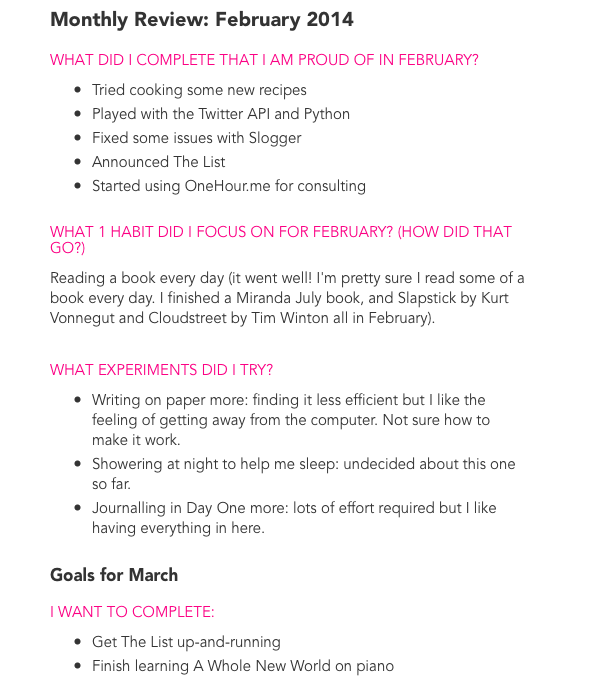Although there are some people who advocate for dropping all your goals or focusing on systems instead of goals, I’ve never managed to fully give up on setting goals for myself.
In fact, I just finished my monthly review today, where I looked at how well I did on the goals I set for myself last month and set some new ones for the month ahead. As I was doing this, I started to wonder whether I was doing myself any favors by reviewing my progress monthly.
I had a look into the science of measuring progress towards your personal goals and how it affects your well-being, as well as some examples of ways to track your own progress.
The science of measuring progress towards personal goals
Firstly, I found a couple of studies that found that improvements in well-being, satisfaction and happiness can come from making progress towards your personal goals.
The caveat here is that your goals need to be in line with your inner needs and motives. If you’re committed to a goal for external reasons such as pleasing your boss or your parents, you won’t see the same emotional improvements when you make progress.
I think we can take this as general guidance when it comes to setting goals: even if we don’t set goals specifically to achieve those emotional improvements, we can still try to focus on the goals that we’re motivated to achieve intrinsically, rather than what we think others expect of us.
I also found evidence that when a goal is more autonomous — that is, it comes from our own motivations rather than being set for us by someone else — we’re more likely to achieve that goal.
A last point in the research on personal goals that I found interesting was the difference between growth goals (those that look forward to achieving something) and avoidance goals (those that are based on maintaining a current state or avoiding a negative change).
Studies have found that setting growth goals is more common in children and younger adults, and has a positive effect on well-being in these age groups, whereas avoidance goals have been found to have a negative emotional impact. Older adults, however, are more prone to setting maintenance and avoidance goals, and interestingly they don’t suffer emotionally—these type of goals seem well suited to the changes we go through as we age.
Age isn’t the only factor, though. Societal factors can play a big role, as found in a study of personal goals in the US, South Korea and Russia. This study found that in the US, which the researchers labelled an individualistic country, avoidance goals had negative effects on well-being over time, whereas this wasn’t the case in South Korea and Russia, both of which were labelled as being collectivistic countries.
Of course, each of these studies asked participants to measure and report progress made towards their goals. Measuring your progress is important if you want to get those positive emotional effects.
4 ways to measure your own progress
You can set a variety of personal goals, and each kind will require different methods of measuring progress. I’ve focused on examples for tracking daily, weekly and monthly progress, but of course you could zoom right out and do an annual review if you have more long-term goals to work towards.
1. Track daily goals with iDoneThis
A tool we use at Buffer to track our work goals is iDoneThis:

iDoneThis sends each of us an email at the end of our workday and a quick reply lets us note down what we got done so we can share it with the team.

We’ve found this helps us to get an overview of our day personally, and see how productive we’ve been, as well as share with the team what our daily progress is on each of our tasks and work goals. Having our progress shared publicly helps to motivate us to get more done, as well.
2. Track daily goals with the Seinfeld method
Comedian Jerry Seinfeld has a method for maintaining a consistent pace of improvement that he shared with another young comedian once. The Internet found out, and it’s since been dubbed the “Seinfeld method” or Seinfeld strategy.
It’s one of my favorite methods of building up a daily habit or progress towards a larger goal. It works like this:
- Keep a calendar where you can check off each day that you complete your daily goal
- Keep doing this every day, and soon you’ll have a chain of days you’ve checked off
- Don’t break the chain
That’s it. Pretty simple, but eventually you’ll find you’ll have hundreds of days chained together, and skipping one will be much harder, since it’ll set you back to a chain of zero.
3. Track weekly progress with a show-and-tell
For tracking weekly progress, I always come back to Y Combinator’s weekly dinners as a reference point. The idea is that all of the founders involved in YC’s current batch come together once a week to hear advice from an eminent person, and to share their progress from the past week.
As Jason Freedman explained in this blog post, the weekly dinners serve as motivation for getting stuff done. Nobody wants to be the founder that shows up without anything to show for themselves, so that peer pressure works positively by pushing everyone to be more productive.
In Jason’s post, he talks about recreating the YC experience without being part of the program. He and his team set up a similar situation, where every week they would show investors and other founders, keeping up the pressure to deliver some progress every week.
This is something you can easily do with personal goals, by setting up a roster of friends, colleagues or family members to meet with weekly. Accountability can go a long way towards motivating you to keep going when your goals seem far away.
4. Complete a monthly personal review
Something I picked up from Buster Benson’s example is the idea of running a monthly review of my personal goals and the progress I’ve made. Buster schedules his as a recurring meeting with himself:
Schedule a 30-minute meeting with yourself to occur in 1 month, and to recur every month after that. Make the meeting non-negotiable, and if for some reason it has to be rescheduled, reschedule it but don’t cancel it.
Buster even sets out a plan that you can follow for your own monthly goals review. Yours will probably depend on what kind of goals you want to track. For instance, Buster’s example includes tracking the interests you’re paying attention to and the most important people in your life. I used to include a section in my review that noted what I’d invested time or money into for the past month, but I decided it wasn’t helping me to understand my progress, so I cut it out.
Reviews are really personal, and they need time to evolve into something you find beneficial for helping you track your progress. Mine currently includes these sections:
- What I completed last month that I’m proud of
- A report on my progress for the one habit I focused on last month
- Notes on any experiments I tried
- Goals for the following month, including one habit I want to focus on regularly
- Notes on long-term goals and personal changes I’m working towards
Here’s part of the one I just finished today:

It takes a bit of effort to complete this every month, and I admire Buster for keeping his a lot shorter. I’d suggest starting with a really short, simple review in a notebook or text file if you’re testing this method.
I’d love to know what works for you: how do you track your progress? What have you tried that didn’t work? Let us know in the comments.
P.S. If you liked this post you might also like What Would Happen If You Improved Everything by 1%: The Science of Marginal Gains and The Myth of Passion and Motivation: How to Stay Focused When You Get Bored Working Toward Your Goals.
Image credit: Lotus Carroll
Try Buffer for free
190,000+ creators, small businesses, and marketers use Buffer to grow their audiences every month.


